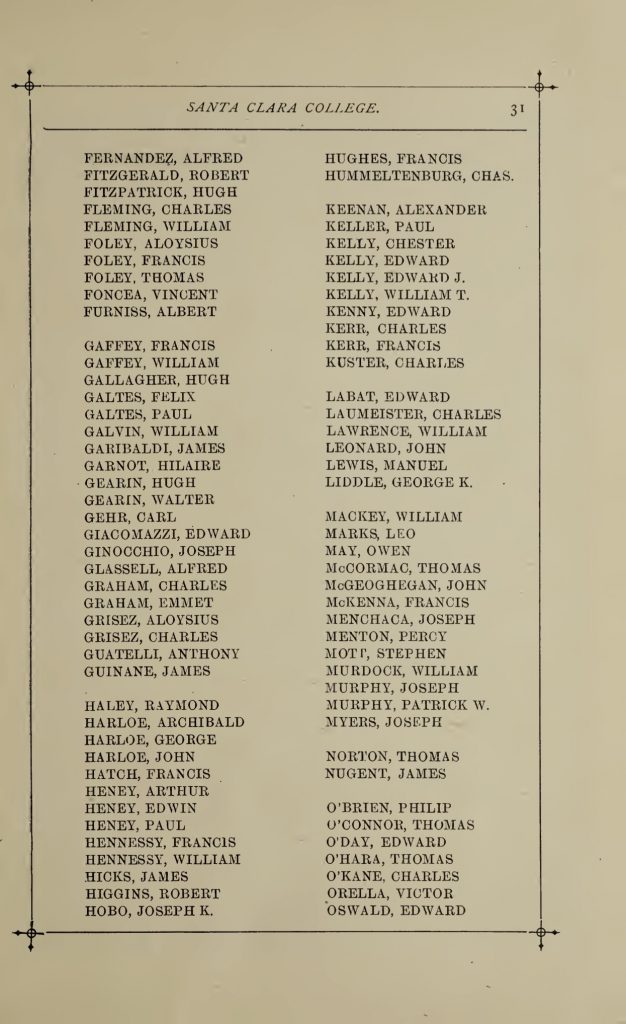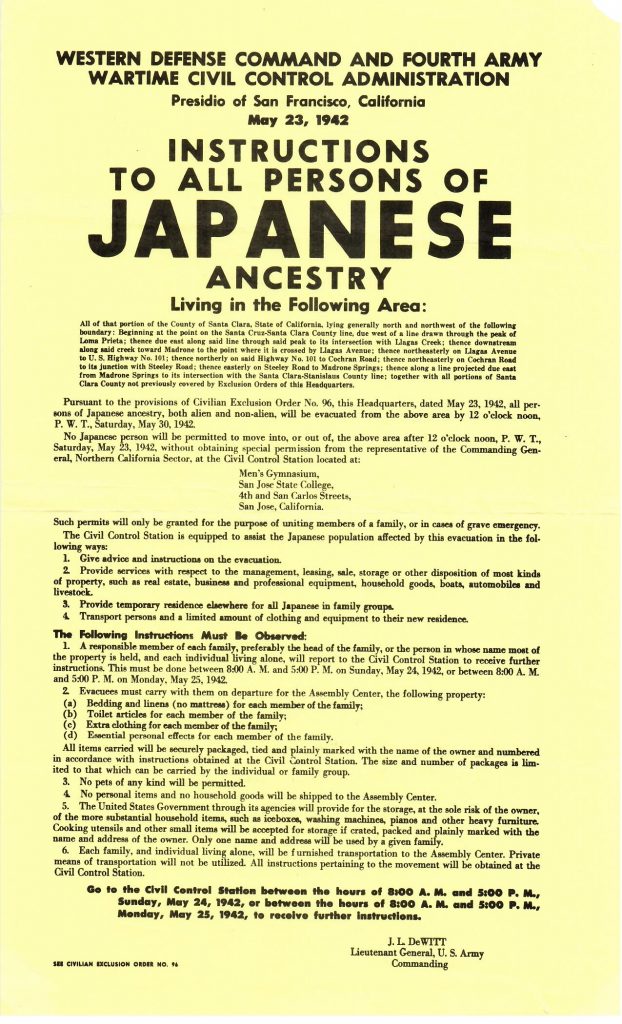His name was Joseph K. Hobo, and as far as I can tell, he was the first Asian student to attend Santa Clara. But some evidence points to Asian students before him—who were they? And how do we find out?

Front view of Santa Clara College cir. 1890 (Image courtesy of SCU Archives)
When Santa Clara first opened its doors in 1851, a majority of the male students were either white Americans or of Hispanic origin. By the 1880s, the college would experience an influx of new boarding students, eventually pushing the housing capacities to lodge 190 attendees. This number did not include day scholars who came to campus for class each day and returned home to local residences in the evening. It wasn’t until the 1890s—forty years after being founded—that Santa Clara College received some of its first Asian students, one being Joseph K. Hobo, a Japanese day scholar who started taking classes in 1895.
Today, we received a day scholar, Mr. Joseph K. Hobo, a Japanese—the first Japanese I think to enter Santa Clara College.”
– Head Prefect’s Log, Jan. 28, 1895 (Giacomini 89)
However, it is unclear who exactly the first Asian student at Santa Clara was. The head prefect’s uncertainty led me to believe that it could be possible for other Asian students–perhaps not Japanese–to be at the college before Hobo. Working with few research leads, I focused on the photo of three Asian students displayed in the header, which comes from the SCU Digital Collections. That picture was one of the only sources from the 1890s that had any mention of Asian scholars at Santa Clara, and the metadata associated with the photo indicates it is from the early 1890s, predating Joseph K. Hobo’s arrival to Santa Clara in 1895. Unfortunately, the names and status of the students shown in this photo are unknown. Even after cross-referencing the image with other pictures in the SCU digital collections, I couldn’t find these three students in any other photos. I then turned to the course catalogs and bulletins digital collection and scanned the student names listed throughout the 1890s looking for Asian surnames. While this method isn’t the most accurate and relies on stereotypical etymology and favors paternal lineages, it’s a quick way to look for other Asian students, and is one of the few methods available for this type of inquiry. While I was able to find Hobo’s name listed, there were no other students that had surnames of Asian origin that I could recognize.

This is a question that is still open for examination: where did the photo of “early Asian students at Santa Clara” come from? Were the subjects of the photo really SCU students? Is the dating of the early 1890s accurate? Sometimes archival research leads to more questions than answers.
Yet, researching Asian students at Santa Clara would eventually lead me to stumble across the story of Maseo “Wayne” Kanemoto, a law student that attended Santa Clara from 1939-1942. Kanemoto was an active student who consistently participated in moot trials since his first year in law school (“Barristers Slate Final Moot Trial”, The Santa Clara). According to reports, he had “…a desire to serve the interests of a largely unrepresented Japanese community” (“Wayne M. Kanemoto Death Notice“, The Mercury News). However, after the bombing of Pearl Harbor and the passing of Executive Order 9066 that incarcerated all people of Japanese descent, Kanemoto was forced to move to a detention center in Arizona only a day before his graduation (“The Effect of War on Santa Clara”, The Santa Clara). Kanemoto’s law professor, George Stepovich, heavily protested this and proclaimed, “they can’t do this.” But Kanemoto bid farewell to his mentor and was taken to be processed in Los Angeles.
On May 30, 1942, while his classmates at Santa Clara were marching up the aisle to receive their diplomas, Kanemoto was marched by military police into the Santa Anita race-track reception center in Los Angeles.”
– (McKevitt 260)

Despite his circumstances, Kanemoto was still determined to become a lawyer. While he was at the Santa Anita internment camp, Kanemoto was able to take the bar exam with a military escort. Later, after being transferred to the Gila River internment camp in Arizona, Kanemoto would then be a given a “rare exception” of being sworn into the California state bar (“Wayne M. Kanemoto Death Notice“, The Mercury News). Although the situation was bleak, Kanemoto still joked about his experience: “He likes to say that he is the only lawyer in California sworn in under the shadow of a saguaro cactus” (“The Nikkei: Hated By Both Sides“, The Mercury News). Kanemoto also volunteered for the 442nd Regimental Combat Team, an all-nisei combat regiment, and went on to serve in India and Burma. After the war, he opened a private law practice in San Jose, which focused on helping Japanese-Americans in the community. He was particularly known for his role in helping many issei Japanese people become naturalized after the law that forbade their citizenship was repealed in 1953. In 1962 Kanemoto was appointed to the San Jose Municipal Court, becoming the first nisei jurist in California (“Wayne M. Kanemoto Death Notice“, The Mercury News).

On May 24, 2008, Kanemoto passed away, but his impact on the San Jose community continues to be felt—all it takes is a spring time walk through Japantown to feel Kanemoto’s influence. While his deeds as a community leader were heavily recorded, his time as a law student in Santa Clara is not as well known.
My initial research on Kanemoto was difficult; while there were articles of his participation in moot trials in The Santa Clara, his first name was continuously misspelled. Luckily, Kanemoto’s surname was spelled correctly, and since it is quite unique, that made it possible for me to find articles mentioning him. But I can’t help but think about those in our community whose achievements weren’t recorded in writing, or whose names were incorrectly recorded, leading to the sublimation of key players in the archival record.
I especially can’t help but wonder who those photographed students were, and what their stories might be. I hope that one day we’ll be able to learn their names, but if historical research has taught me anything, it’s that sometimes questions will be forever left unanswered. This doesn’t mean nothing is gained from this pursuit of knowledge. In fact, it serves as a reminder that moving forward we should work to amplify the voices of our minority community members, as these stories often empower those who seek role models that are similar to them.

Header photo: Asian Students at Santa Clara College, circa 1890 (Image courtesy of SCU Archives)
Works Cited
Giacomini, George F., and Gerald McKevitt. Serving the Intellect, Touching the Heart: A Portrait of Santa Clara University, 1851-2000. Santa Clara University, Santa Clara, Calif, 2000.
McKevitt, Gerald. The University of Santa Clara: A History, 1851-1977. Stanford University Press, Stanford, CA: 1979.
WATANABE, TERESA. “THE NIKKEI: HATED BY BOTH SIDES.” San Jose Mercury News (CA), Stock Final ed., sec. Front, 13 Aug. 1985, p. 1A. NewsBank: Access World News Research Collection, infoweb.newsbank.com/apps/news/document-view?p=AWNB&docref=news/0EB724B7EA7A7A82. Accessed 10 May 2021.
“Wayne M. Kanemoto.” San Jose Mercury News (CA), sec. Death Notice – Classified, 31 May 2008. NewsBank: Access World News Research Collection, infoweb.newsbank.com/apps/news/document-view?p=AWNB&docref=news/1210D19FE71DC370. Accessed 10 May 2021.

